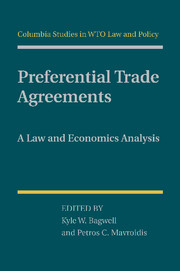Book contents
- Frontmatter
- Contents
- Contributors
- Introduction: The Law and Economics of Contingent Protection
- 1 Preferential Trading Agreements: Friend or Foe?
- The “Legalization” of GATT Article XXIV – Can Foes Become Friends?
- 2 Third-Country Effects of Regional Trade Agreements
- 3 Contingent Protection Rules in Regional Trade Agreements
- 3.1 Commentary on “Contingent Protection Rules in Regional Trade Agreements”
- 4 The Limits of PTAs
- 5 EU and U.S. Preferential Trade Agreements: Deepening or Widening of WTO Commitments
- Straightening the Spaghetti Bowl
- 5.1 Comments on “Beyond the WTO? Coverage and Legal Inflation in EU and U.S. Preferential Trade Agreements”
- 6 Labor Clauses in EU Preferential Trade Agreements – An Analysis of the Cotonou Partnership Agreement
- 7 Do PTAs Actually Increase Parties' Services Trade?
- 8 A Model Article XXIV: Are There Realistic Possibilities to Improve It?
- 8.1 Comments on “A Model Article XXIV: Are There Realistic Possibilities to Improve It?”
- Index
- References
2 - Third-Country Effects of Regional Trade Agreements
Published online by Cambridge University Press: 03 May 2011
- Frontmatter
- Contents
- Contributors
- Introduction: The Law and Economics of Contingent Protection
- 1 Preferential Trading Agreements: Friend or Foe?
- The “Legalization” of GATT Article XXIV – Can Foes Become Friends?
- 2 Third-Country Effects of Regional Trade Agreements
- 3 Contingent Protection Rules in Regional Trade Agreements
- 3.1 Commentary on “Contingent Protection Rules in Regional Trade Agreements”
- 4 The Limits of PTAs
- 5 EU and U.S. Preferential Trade Agreements: Deepening or Widening of WTO Commitments
- Straightening the Spaghetti Bowl
- 5.1 Comments on “Beyond the WTO? Coverage and Legal Inflation in EU and U.S. Preferential Trade Agreements”
- 6 Labor Clauses in EU Preferential Trade Agreements – An Analysis of the Cotonou Partnership Agreement
- 7 Do PTAs Actually Increase Parties' Services Trade?
- 8 A Model Article XXIV: Are There Realistic Possibilities to Improve It?
- 8.1 Comments on “A Model Article XXIV: Are There Realistic Possibilities to Improve It?”
- Index
- References
Summary
Introduction
More than 200 regional trade agreements are currently in force. More than half of these agreements were implemented after the conclusion of the Uruguay Round in 1995, and many new agreements are currently under negotiation. In contrast, multilateral liberalization through the WTO has stalled: after seven years of negotiation, agreement among members on further multilateral trade liberalization remains unattainable. These facts speak for themselves; regionalism has been the dominant force for negotiated trade liberalization in recent years. This has led economists to reexamine the implications of regionalism both theoretically and empirically for trade, welfare, and the world trade system. Many concerns have arisen, leading many prominent trade economists to oppose regionalism as a means of trade liberalization.
At issue is the discriminatory nature of regional trade agreements (RTAs). Although tariff preferences stimulate trade among bloc members, they can have deleterious effects on nonmembers, potentially even on members, and on the political economy of trade policy formation. There are three main concerns. The first is trade diversion: RTAs may lead to diversion of imports away from the most efficient global producers to regional partners. This means that the formation of trade blocs can be welfare reducing (even for the member countries) if little new trade is created. The second concern is that regionalism may hinder unilateral and multilateral tariff reduction, leading to a bad equilibrium, with several trade blocs maintaining high external trade barriers.
- Type
- Chapter
- Information
- Preferential Trade AgreementsA Law and Economics Analysis, pp. 40 - 59Publisher: Cambridge University PressPrint publication year: 2011

